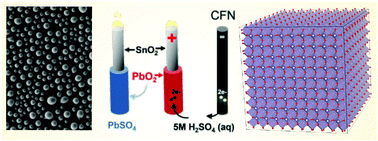Vapor–liquid–solid growth and properties of one dimensional PbO and PbO/SnO2 nanowires
Abstract
PbO nanowires have been obtained via a self-catalysed, vapor–liquid–solid mechanism and the reaction of Pb with O2 between 200 °C and 300 °C at 10 Pa. These had the form of tapes with a thickness of ∼20 nm, a width of ∼150 nm, and a length of up to ∼100 μm with a mixed orthorhombic and tetragonal crystal structure. The intermediate temperatures between 300 °C and 500 °C resulted in the formation of urchin-like structures but higher temperatures lead to a suppression of one-dimensional growth. We found that the morphology can be tuned in a reproducible way by adjusting the pressure, in which case we obtained two-dimensional plates at 1 kPa and spherical particles with diameters of ∼1–10 μm at 1 Pa for all temperatures between 100 °C and 500 °C. We did not obtain any PbO2 nanowires irrespective of the growth temperature and pressure but PbO nanowires were grown on SnO2 nanowires that were subsequently converted into PbO2/SnO2 branched nanowires, which are attractive for energy storage and the realization of advanced lead acid batteries. We describe in detail the properties of the PbO/SnO2 heterojunction by density functional theory calculations and show that it has a type II band line-up, which is also important for energy conversion, e.g. solar cells and photocatalysis.



 Please wait while we load your content...
Please wait while we load your content...